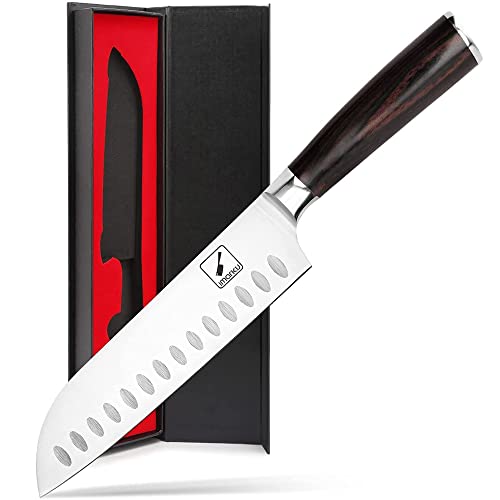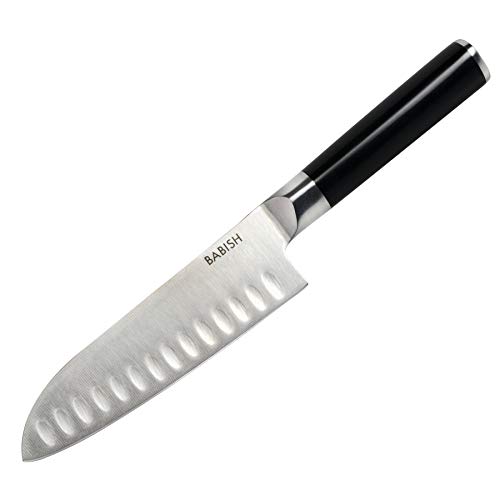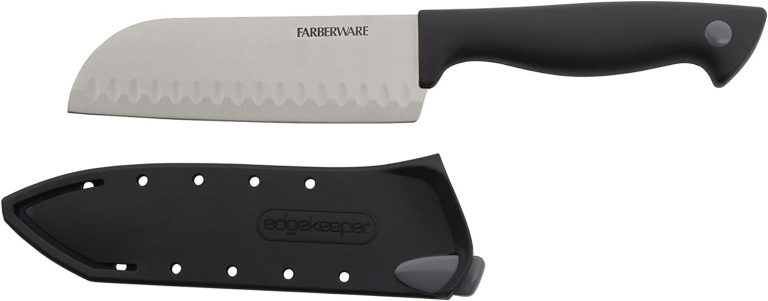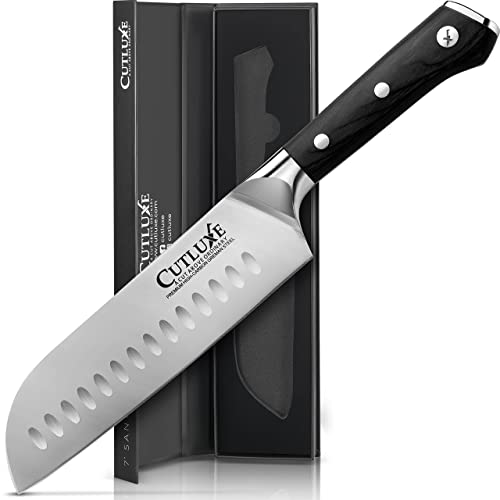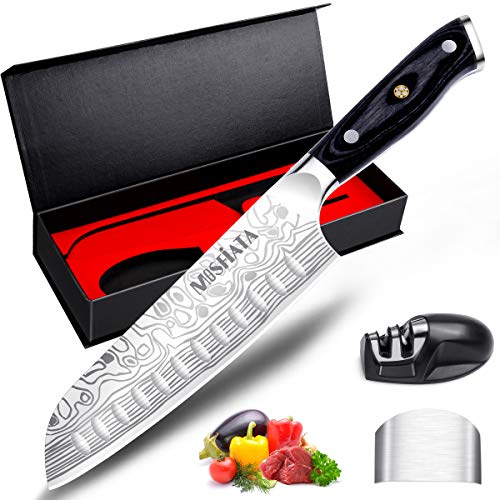- sign in
- Design
- Food
- Pop Culture
- Style
- DIY Classes
The Best Santoku Knives for Slicing and Dicing Like a Pro
E-Commerce WriterPublished on October 2, 2023Last updated on May 25, 2024In the ever-evolving culinary world, one enduring star shines brightly: the santoku knife. It's not just any kitchen tool, but an essential partner to any earnest professional chef or culinary enthusiast. This type of knife is the embodiment of precision, balance, and versatility — and it makes every slicing or dicing task easy and enjoyable.
What makes the highest-rated santoku knives in 2024 so noteworthy is their unparalleled craftsmanship and adaptability. In this article, we'll take a close look at these top options that cater to a wide variety of culinary needs. We'll also share some useful buying tips to help you make an informed purchase. So, let's delve deeper and unearth the artistry and performance of these star performers in kitchenware. With a premium santoku knife, you'll be prepared to hone your cooking skills in no time.
If you're looking for a kitchen knife to make quick work of your cooking tasks, consider the imarku Ultra Sharp Santoku Knife. This isn't just any ordinary knife, it's a game-changer in the culin...
read moreImportant Features- Made from German stainless steel
- Ultra-sharp edge for precise cutting
- Blade thickness of 2.5mm; length of 7 inches
- Hand-polished edge angles of 15-18 degrees
- Ergonomic pakkawood handle
- Comes in a high-quality black gift box
Just when you think you've seen it all in kitchen cutlery, along comes the Babish High-Carbon Santoku Knife, featuring a 6.5-inch blade that stands out in a crowded field of contenders. This opti...
read moreImportant Features- Constructed using high-carbon 1.4116 German steel
- Single-piece forging for durability
- Sharpened and polished for optimal cutting
- Full-tang handle design for balance
- Granton edge reduces food stickiness
If you're searching for an affordable option that delivers excellent performance, check out the Farberware Edgekeeper Santoku Knife. This isn't just your regular kitchen blade, it's a dazzling mu...
read moreImportant Features- Oval indentations for smooth cutting
- Features built-in blade sharpener
- Comes with EdgeKeeper protective sheath
- High-carbon stainless steel 5-inch blade
- Recommended to hand wash after use
Get ready to prep vegetables with ease with the Cutluxe Santoku Knife! This 7-inch chopping kitchen knife is made from high-carbon German steel, renowned for its outstanding cutting performance a...
read moreImportant Features- Blade hand-sharpened at 14-16 degrees
- Triple-riveted pakkawood handle for secure grip
- Sanitary laminated and polished handle
- Forged from high-carbon German steel
- Comes with a lifetime warranty
If you care as much about style as you do durability and performance, the MOSFiATA Santoku Knife is about to become your new favorite tool in the kitchen. Its superb sharpness and durability are sim...
read moreImportant Features- High-carbon German stainless steel construction
- Anti-rust, corrosion, and discoloration
- Thickness of 5mm with a 14-16 degree edge
- Durable Micarta handle with triple reinforced rivet design
- Rockwell hardness: 56 ± 2 HRC
- Presented in a quality black gift box
Comparing the Top Santoku Knives of 2024
Best Overallimarku Ultra Sharp Santoku Knife
If you’re looking for a kitchen knife to make quick work of your cooking tasks, consider the imarku Ultra Sharp Santoku Knife. This isn’t just any ordinary knife, it’s a game-changer in the culinary world. Combining German stainless steel and Japanese craftsmanship, it boasts exceptional sharpness and durability that puts it in a league of its own. It cuts through vegetables, meats, and fish as if they were butter, making your prep work a breeze. Thanks to vacuum heat treatment and nitrogen cryogenic tempering, the 7-inch blade’s sharpness is simply outstanding and you’ll be amazed at how easy it is to maintain that edge over time.
But what makes this kitchen knife even more special is how user-friendly it is, especially for people with arthritic hands. The ergonomic pakkawood handle is designed to reduce wrist tension and provide a secure, comfortable grip even during extended use. The aesthetics are impressive, too. This knife’s sleek design combined with the natural beauty of the handle makes it a beautiful kitchen tool. This Santoku knife is the best overall choice due to its long-lasting sharpness and ergonomic handle.
Pros- Exceptional sharpness, even with intensive use
- Lightweight and easy to hold
- Gorgeous and durable construction
Cons- Not ideal for individuals with large hands
Best for Daily UseBabish High-Carbon Santoku Knife
Just when you think you’ve seen it all in kitchen cutlery, along comes the Babish High-Carbon Santoku Knife, featuring a 6.5-inch blade that stands out in a crowded field of contenders. This option boasts exceptional sharpness and longevity, so it’s great for frequent, daily use. Made with high-carbon German steel, this knife doesn’t just perform excellently; it stays sharp for an astonishingly long time.
But what makes this Santoku knife so impressive is its reliability for daily use. Whether you’re finely slicing vegetables, dicing ripe tomatoes, or mincing garlic for your favorite dish, this knife is up to the task. It’s not just for the professional chefs out there; home cooks will find it equally useful and dependable. It’s a versatile tool, suitable for a plethora of kitchen tasks. The heft and balance of this knife and its double-bolstered handle also make it comfortable to use, which is a bonus for individuals who spend a lot of time in the kitchen.
Pros- Maintains sharpness over prolonged periods
- Remarkable durability and longevity
- Superior quality relative to its price
Cons- Triangular grip is uncomfortable for large hands
If you’re searching for an affordable option that delivers excellent performance, check out the Farberware Edgekeeper Santoku Knife. This isn’t just your regular kitchen blade, it’s a dazzling multi-purpose tool that’s ideal for precision cuts and chopping. Thanks to its shorter blade length of 5 inches and flat cutting edge, you can slice your way through any ingredient with the utmost ease. This knife also boasts oval indentations on the blade that keep your tasty morsels from sticking to it. Now isn’t that ingenious?
One of the highlights of this Santoku knife that adds to its value is its self-sharpening blade cover. Yes, you read that right! No more fretting about a dull blade right when you’re in the middle of prepping dinner. Each time the knife is drawn from its cover, it gets a quick sharpening, ensuring it’s sharp at all times. It also comes with an ergonomically designed handle which ensures a comfortable grip, making it ideal for extensive cooking sessions. The knife’s high carbon stainless steel blade provides long-lasting sharpness.
Pros- Comes with a self-sharpening cover
- Prevents food from sticking to the blade
- Has an ergonomic, comfortable grip
Cons- Handle may feel awkward for some individuals
Best for Large VegetablesCutluxe Santoku Knife
Get ready to prep vegetables with ease with the Cutluxe Santoku Knife! This 7-inch chopping kitchen knife is made from high-carbon German steel, renowned for its outstanding cutting performance and durability. You’ll find it slices through larger vegetables with absolute ease, making meal prep quicker and more enjoyable.
But it’s not just about performance — this knife is designed with comfort in mind, too. The full tang structure ensures optimal balance, making it feel like an extension of your hand. Plus, the ergonomic handle design takes the strain off your wrist, letting you chop, slice, and dice for longer without fatigue. This pick is part of the Cutluxe Artisan Series, so it doesn’t just perform well, it looks great, too. You can rest assured you’re making a long-term investment in this Santoku knife as well since it comes with a lifetime warranty.
Pros- Razor sharp and holds edge well
- Well-balanced and durable construction
- Sleek, professional-looking design
Cons- Goes dull quickly with frequent use
Most Eye-Catching DesignMOSFiATA Santoku Knife
If you care as much about style as you do durability and performance, the MOSFiATA Santoku Knife is about to become your new favorite tool in the kitchen. Its superb sharpness and durability are simply unmatched. Crafted from high-carbon German stainless steel, this knife takes cutting and chopping to the next level. This isn’t your run-of-the-mill stainless steel we’re talking about here, but a superior blend that provides a lifetime of precise, effortless slicing.
This santoku knife’s eye-catching blade design is something to rave about. Not only does this knife perform well, but it also looks fantastic. Its Micarta handle with reinforced rivets ensures a comfortable and secure grip, so you can chop away with confidence. And guess what? It comes equipped with a finger guard and knife sharpener for added safety and maintenance, all packaged in an elegant gift box. It’s not every day that you come across a knife that combines functionality and style so seamlessly.
Pros- High-quality, versatile performance
- Includes finger guard and sharpener
- Beautiful blade design
Cons- Can rust if not properly dried
Buying Guide: Finding the Perfect Santoku Knife
When it comes to cooking, the right tools make all the difference. If you’re looking for an all-around, versatile kitchen knife, the Santoku knife is your best bet. This product of Japanese craftsmanship is perfect for slicing, dicing, and mincing all types of ingredients. But how do you find the best santoku knife? Read on, and we’ll guide you through the process.
Blade Material
First and foremost, consider the blade material. The best santoku knives typically have high-carbon stainless steel blades. This material is razor-sharp, durable, and resistant to rust and corrosion. However, ceramic blades are a good choice for those who prefer lightweight knives. They’re still incredibly sharp and maintain their edge longer than steel blades. When choosing the blade material, consider your cooking needs and preferences.
Blade Length
The length of a Santoku knife blade usually ranges between 5 and 7.5 inches. A shorter blade offers more control, making it ideal for precise tasks such as mincing herbs. On the other hand, a longer blade is perfect for slicing larger items like melons or cabbage. You need to determine what you’ll be using the knife for to pick the right length. Remember, there is no “one size fits all” when it comes to santoku knives, so you may even prefer to invest in several knives of different lengths.
Handle Design
Next, let’s talk about the handle design. A comfortable handle is key to effectively using your santoku knife. Look for a handle that fits well in your hand, is balanced with the blade, and has an ergonomic design. Materials such as wood, plastic, or composite are common in santoku knives. Wooden handles give a traditional feel, while plastic and composite ones are durable and easy to clean.
Knife Balance
The balance of a santoku knife refers to the weight distribution between the blade and the handle. A well-balanced knife allows for comfortable use and precise cutting. You don’t want a knife that’s too heavy on the blade end or the handle end. An imbalanced knife can cause strain and lead to inaccurate cuts. So, make sure you check the balance before buying a santoku knife.
Sharpness
Santoku knives are known for their sharpness, but not all Santoku knives are created equal. The best kitchen knives have a sharp blade that maintains its edge even after repeated use. They should be able to cut through items with ease, without the need for sawing. Look for a knife with a sharp, straight edge and a slight curve towards the tip.
Price
Finally, consider the price. Santoku knives can range from as low as $10 to several hundred dollars, depending on the materials and craftsmanship. However, don’t let a cheap price tag tempt you. Often, lower-priced knives may not offer the same quality and durability as their higher-priced counterparts. We recommend setting a budget and spending a little more for a knife that will last and perform well.
Santoku Knife FAQs
Q: What is a santoku knife?A: A santoku knife is a versatile Japanese knife that is used for a variety of cutting tasks. The word "santoku" means "three virtues" in Japanese, representing its three primary functions: slicing, dicing, and chopping. It typically has a shorter, wider blade than other types of knives and is perfect for making precise cuts.
Q: How do I use a santoku knife?A: You use a santoku knife like any other kitchen knife, but it's most effective with a downward or rocking motion rather than a sawing motion. Its broad blade can also be used to scoop up chopped ingredients to transfer them to a bowl or pan.
Q: How should I maintain my santoku knife?A: To maintain your santoku knife, clean it with warm water and mild dish soap after every use. Dry it thoroughly to prevent rust and store it in a knife block or sheath to protect its blade.
Q: Can I sharpen my santoku knife, and if so, how?A: Yes, you can sharpen your santoku knife using a whetstone or a knife sharpener. If using a whetstone, hold the blade at an angle of about 15 degrees and slide it across the stone. If you're not comfortable doing this yourself, consider getting it professionally sharpened.
Q: Why is my santoku knife not cutting as well as it used to?A: If your santoku knife isn't cutting as well as before, it might be due to dullness. Regular use can cause the knife's edge to become dull over time. To restore its sharpness, you should sharpen it.
Q: Is a santoku knife suitable for all types of food?A: The santoku knife is versatile and can be used for most types of food, including vegetables, fruit, and meat. However, it's not suitable for cutting through hard materials like bones or frozen foods as it may damage the blade.
Q: What makes a santoku knife different from a chef's knife?A: While both are versatile, the santoku knife has a shorter, wider blade than a chef's knife, and its edge is straighter. This makes the santoku knife ideal for precise cuts and fine slices. Meanwhile, a chef's knife, with its curved edge, is perfect for a rocking motion for mincing.
Q: Can I put my santoku knife in the dishwasher?A: While some santoku knives are dishwasher safe, it's generally recommended to hand wash them to prevent potential damage to or dulling of the blade. Always remember to dry it thoroughly after washing to prevent rust.
We may earn a commission if you make a purchase through one of our links. The newsroom or editorial staff was not involved in the creation of this content.Natalie is a graduate from the Ohio State University where she studied English. She edits content about lifestyle and education. In her free time, she enjoys trying new recipes, reading in the park, and exploring her city of Columbus, Ohio.

